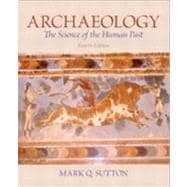
In this Section:
1. Brief Table of Contents
2. Full Table of Contents
BRIEF TABLE OF CONTENTS:
Part 1: What is Archaeology?
Chapter 1: The Science of Archaeology
Chapter 2: Backgrounds of Archaeology
Chapter 3: The Development of Contemporary Archaeology
Part 2: Obtaining Information About the Past
Chapter 4: The Archaeological Record
Chapter 5: Conducting Fieldwork
Chapter 6: Classification and Analysis of Artifacts
Chapter 7: Determining Time
Chapter 8: Bioarchaeology: Human Remains
Part 3: Interpreting the Past
Chapter 9: Environment and Adaptation
Chapter 10: Understanding Past Settlement and Subsistence
Chapter 11: Interpreting Past Cultural Systems
Chapter 12: Understanding Culture Change
Part 4: Public Achaeology
Chapter 13: Cultural Resource Management
Chapter 14: Archaeology in the Real World
FULL TABLE OF CONTENTS:
Part 1: What is Archaeology?
Chapter 1: The Science of Archaeology
What Is Archaeology?
The Branches of Archaeology
Key Concepts in Archaeology
Archaeology as Science
The Importance of Archaeology
Chapter 2: Backgrounds of Archaeology
Ancient Archaeology
Antiquarians
The Discovery of Prehistory
The Emergence of Professional Archaeology
Developing the Outline of World Prehistory
Political Influences in the History of Archaeology
Chapter 3: The Development of Contemporary Archaeology
Archaeology after World War II
The Rise of Scientific Archaeology
Expanding Theoretical Horizons
Archaeological Frontiers
Careers in Archaeology
Part 2: Obtaining Information About the Past
Chapter 4: The Archaeological Record
Archaeological Sites
Archaeological Evidence
Site Formation and Transformation
Preservation
Recognizing and Recovering Evidence
Ongoing Impacts on the Archaeological Record
Chapter 5: Conducting Fieldwork
Finding Sites
Conducting Archaeological Surveys
Excavating Sites
Practical Aspects of Fieldwork
Ethics in Archaeological Fieldwork
Chapter 6: Classification and Analysis of Artifacts
Classification and Typology
Classifying Types of Artifacts
Analyzing Artifacts
Chapter 7: Determining Time
What Is So Important about Time?
Older or Younger? Relative Dating in Archaeology
Real Time: Chronometric Dating
Chapter 8: Bioarchaeology: Human Remains
The Study of Human Remains: Getting to Know Past Peoples
Preserved Bodies
Skeletal Remains
Analytical Approaches in Bioarchaeology
Part 3: Interpreting the Past
Chapter 9: Environment and Adaptation
The Environment
Environmental Archaeology
Human Biological Adaptation
Human Cultural Adaptation
Domestication and the Agricultural Revolution
Chapter 10: Understanding Past Settlement and Subsistence
How Did People Make a Living? Subsistence
Where Did People Live? Past Settlement Systems
The Interplay between Subsistence and Settlement
Chapter 11: Interpreting Past Cultural Systems
How Can Archaeology Answer Anthropological Questions?
Interpreting Past Social Structures
Interpreting Past Political Organization
Interpreting Past Belief Systems
Remembering the Individual
Chapter 12: Understanding Culture Change
The Archaeology of Change
Interpreting Evidence of Change
Cultural Contact and Conflict
Part 4: Public Achaeology
Chapter 13: Cultural Resource Management
The Impact of Population Growth and Development on Archaeology
The Field of Cultural Resource Management
The Role of Public Education in Archaeological Preservation
Cultural Resource Management among Traditional Peoples
Chapter 14: Archaeology in the Real World
Archaeology Today
Archaeology and Politics
Who Owns the Past?
Learning from the Past: Applying Archaeology to Contemporary Problems
Archaeology and Computer Technology
Archaeology, Mass Media, and Public Perception
So What? The Significance of Archaeology
The New copy of this book will include any supplemental materials advertised. Please check the title of the book to determine if it should include any access cards, study guides, lab manuals, CDs, etc.
The Used, Rental and eBook copies of this book are not guaranteed to include any supplemental materials. Typically, only the book itself is included. This is true even if the title states it includes any access cards, study guides, lab manuals, CDs, etc.